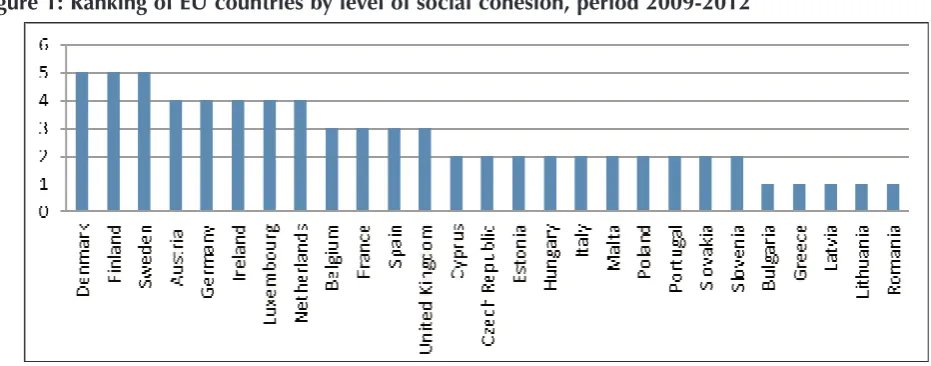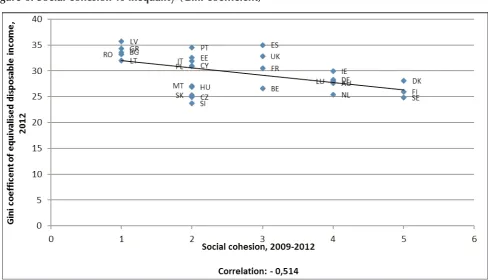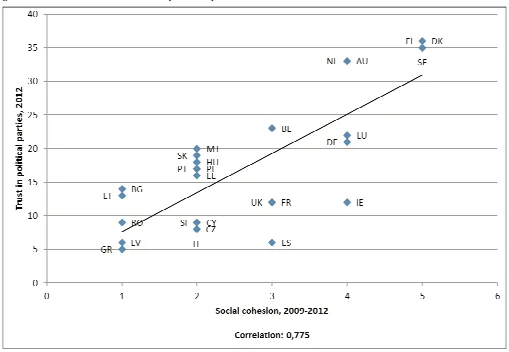DISCUSSION PAPER
Fostering social cohesion: the missing link in the
EU’s exit strategy from the crisis
Claire Dhéret
31 March 2015
Introduction
Undoubtedly, promoting and strengthening social cohesion is a cherished principle shared by European societies. Not only is it stipulated as a fundamental objective in the EU Treaty1
but it also forms an integral part of the historical legacy of European welfare states and their democratic political systems. These two elements are the foundations of, and important vectors for, Europe's social cohesion. While the welfare state has emerged to create equal opportunities for everyone, to protect citizens against social risks and replace informal solidarity by concrete and institutionalised mechanisms such as tax transfers and public services, Europe's democracy has put the notion of citizens' participation and engagement at the heart of our societies and made them a pre-condition for legitimacy.
Social cohesion in Europe is therefore a respected notion, which resurfaced in the public sphere due to the rise in social polarisation that has followed the economic crisis and the implementation of austerity measures. Against this background, events such as the spread of religious radicalism among young people, the emergence of violent riots initiated by European youth in countries perceived as very cohesive societies (like Sweden), low turn-out in elections and the rise in extremist parties caught the public's attention more so than ever before. These incidents triggered a wave of anxious commentaries in the media, desperately announcing the erosion of social cohesion in Europe and questioning Europe's capacity to deal with diversity. In such a context, the question as to which policies are best suited to protect social cohesion has increasingly become a dividing line for political parties and a matter of increased politicisation.
Despite the undeniable attention that the topic is receiving, social cohesion is still largely perceived as a topic for sociologists rather than a consideration requiring regular and in-depth policy monitoring. Contrary to other EU objectives, neither is the level of social cohesion duly assessed nor is it established as a concrete policy priority in the EU strategic frameworks.
The objective of this paper is not to add another set of indicators to the existing literature but rather to discuss the importance of social cohesion in Europe, to assess its recent developments, and to draw some policy conclusions based on an analysis of the interaction between social cohesion and other indicators, including macro-economic and social ones. This exercise is particularly important given that social progress is usually discussed through the prism of macro-economic figures, which are now, and since the outset of the economic crisis, the spread of the fiscal consolidation mantra and the build-up of the European economic governance, dominating the policy agenda. Exploring the relation between social cohesion and other indicators is therefore a useful exercise to draw conclusions on possible policy implications that go beyond the current focus on fiscal consolidation.
Social cohesion in the EU: where do we stand?
Social cohesion has already been a topic widely discussed in the literature but as mentioned earlier, its definition and the way to measure it may vary.
According to the OECD (2011), a cohesive society is one "where citizens feel they can trust their neighbours and state institutions, where individuals can seize opportunities for improving their own well-being and the well-being of their children. It is a society where individuals feel protected when facing illness, unemployment and old age". The OECD also considers that social cohesion is based on three main components of equal importance: social inclusion, social capital and social mobility.
Other sources are less explicit with respect to the role of the state in protecting citizens against social risks and do emphasise more on the quality of the social fabric. For instance, Easterly (2006) describes social cohesion as the nature and extent of social and economic divisions (such as by income, ethnicity, political party, caste language or other variables) within society, which represent vectors around which politically salient societal cleavages can develop.
In a recent study by the Bertelsmann Foundation (2013), social cohesion is seen as the result of the attitudes and behaviour of the individuals and groups in a given society. A cohesive society is therefore characterised by resilient relations, a positive emotional connectedness between its members and the community and a pronounced focus on the common good. These elements are, according to the study, the three core aspects of social cohesion and each of them is measured by a set of three indicators2leading to the country ranking pictured
[image:2.595.54.520.538.721.2]in Figure 1. As indicated below, the most cohesive societies are found in Nordic countries, i.e. Denmark, Finland, and Sweden, while social cohesion is very low in South-eastern Europe, in particular Bulgaria, Greece, and Romania, as well as in Baltic countries such as Latvia and Lithuania.
Figure 1: Ranking of EU countries by level of social cohesion, period 2009-2012
As shown by the same source, comparing the level of social cohesion over the period running from 2009 to 2012 with previous decades indicates that there is very little change over time. The level of social cohesion in each country does not change much and the ranking of countries remains very similar (see Figure 2). This result illustrates very clearly that social cohesion is the outcome of a long-lasting legacy and of a delicate equilibrium of policies, which cannot be easily reversed by short-term changes. In other words, social cohesion is a complex construct, which requires stable and coherent policies and which can only be built over years, or even decades. Figure 2: Ranking of EU countries by level of social cohesion, period 1989-1995
Source: Bertelsmann Stiftung (2013), Social Cohesion Radar – An International Comparison of Social Cohesion.
However, the stability of the social cohesion level over time, in particular despite the ups and downs of economic cycles, remains striking and merits further attention. The recent history of Sweden is clearly a case in point. While the country went through a deep crisis in the early 1990s, its level of social cohesion remained high. Arguably, this can lead to two interpretations: on the one hand, one could argue that periods of economic prosperity are not sufficient to reinforce social cohesion. On the other hand, social cohesion seems to resist well to economic shocks. The next section will look more carefully at the question of what determines social cohesion by exploring its relationship with other indicators.
What economic and social context for social cohesion?
This section will look into the correlation between social cohesion and two sets of indicators. The first one includes the indicators which are the most commonly used to measure a country's economic performance, i.e. GDP per head and unemployment. The second one has a strong social dimension and comprises the level of poverty, inequality, and the level of social expenditure.
The relation between social cohesion and macro-economic indicators
determines growth, the latter proves that weak public institutions and divided societies respond worse to economic shocks than united societies with high quality institutions.3
[image:4.595.62.533.193.586.2]Indeed, a society, which already enjoys tight social connections among its members, a high level of trust and a pronounced focus on the common good is more likely to overcome economic shocks and to trust its government that painful changes arising from reforms will be offset by long-term gains. The absence of social cohesion should therefore be considered as one of the factors explaining the difficulties some Member States have to introduce some structural reforms and make them accepted by their citizens.
Figure 3: Social cohesion vs GDP per head
Figure 4: Social cohesion vs level of unemployment
Source: Bertelsmann Stiftung (2013), Eurostat.
The relation between social cohesion and social indicators
Figure 5: Social cohesion vs poverty rate
Source: Bertelsmann Stiftung (2013), Eurostat.
Figure 6: Social cohesion vs inequality (Gini coefficient)
[image:6.595.52.541.454.734.2]Figure 7: Social cohesion vs social protection expenditure (% of GDP)
Source: Bertelsmann Stiftung (2013), Eurostat.
The hidden face of social cohesion and its policy implications
A crucial part of the equation: The importance of trust
The previous sections have shed light on two important elements for further research on the implications of social cohesion on policy. First, the level of social cohesion in a given society is deeply anchored and evolves slowly over time. Second, socially cohesive societies combine above-average macro-economic indicators and good results in social indicators. However, performing well in one type of these indicators is not sufficient, as illustrated earlier by examples, to foster social cohesion. Part of the explanation is that social cohesion is the result of a complex set of policies, which all interact with each other. But what is the 'glue' explaining the success of this set of policies and holding society together?
Figure 8: Social cohesion vs trust in the National Parliament
Figure 9: Social cohesion vs trust in political parties
Source: Bertelsmann Stiftung (2013), Standard Eurobarometer 78.
Although there are certainly exogenous factors, such as the ethnic and linguistic fragmentation in a society, which might challenge the degree of trust among the population and the cohesiveness of a society, this does not mean that policy-makers have no impact on them. Trust and social cohesion are largely shaped by national leaders, who either decide to unify fractionalised people or to exploit their differences.4
The impact of the crisis on social cohesion – What is behind aggregate figures?
below inflation, whereas spending on housing and old age increased more than inflation. As a result, one can observe that the deterioration of social indicators has been much steeper for young people than the elderly. For instance, child poverty increased on average by 4.4 percentage points in 16 out of 28 countries between 2007 and 2012 while the elderly Severe Material Deprivation Rate has declined on average by 4.5 percentage points in 20 out of 28 countries.6In addition, the number of young people not in employment, education or training –
the so-called NEETs – continues to increase and youth unemployment was at 22.5% in April 2014, while employment growth has so far primarily benefited older workers (55-64).
A new generational divide is therefore emerging in a lot of Member States. This new trend is certainly worrying in itself but it becomes even more disquieting when demographic changes are taken into account. Indeed, data shows that the number of people aged 65 or above relative to those aged 15-64 is projected to increase from 26% to 52.5% in the EU by 20607
, meaning that population ageing will result in a smaller percentage of workers supporting a greater number of inactive people. This imbalance gets even worse when one takes the economic dependency ratio (defined as the number of unemployed people and pensioners relative to the number of people in employment) into account and assumes that the unemployment rate will remain high in the decades to come.8
Against this background and given the current functioning of pension systems in most Member States, the young generation will have to pay a heavy price to finance the pension of the previous generations.
This uneven equilibrium between generations has, mistakenly, not received high political attention so far. However, the sentiment of paying disproportionately for the damage of the crisis instead of getting as much support as the older generation is likely to gain ground in young people's minds and to backfire in the years to come. Not only can it create a breakdown in intergenerational solidarity and in the informal nexus of support between generations and families, which represents a key pillar of social cohesion, but it could also call the existence of European welfare states into question and fuel extreme political forces. Some signals of the growing disenchantment of young people with politics have already surfaced through, for instance, their growing support for anti-establishment parties in the last European elections. Responsibility lies with policy-makers not to ignore these signals, to consider the issue of young people's resentment more seriously and to undertake the necessary measures to address simultaneously the disproportionate impact of the crisis and austerity programmes on young people and their growing apathy towards the proposals brought forward by mainstream political parties.
Conclusion
This paper has shown that social cohesion is a complex construct, profoundly rooted in societies and resulting from a delicate equilibrium of a broad set of policies. Indeed, macro-economic performance and welfare state policies are strongly correlated with social cohesion but none of them are self-sufficient to promote cohesive societies. Social cohesion requires the right mix of policies enabling people to live in wealthy societies, to feel protected against social risks and to live up to their full potential to take part in social and economic life through equal opportunities. A simultaneous pursuit of economic and social progress is therefore required.
But this paper has also highlighted that trust, both among the population and vis-à-vis public institutions and the political establishment, is a key element to nurture social cohesion. Unfortunately, this aspect is completely absent of the EU policy agenda. As it has been proved that trust and social cohesion determine the quality of institutions, which in turn has important impacts on a country's capacity to introduce the right reforms and to conduct pro-growth policies9, it raises the question of why the EU is not more active in this area. Is fiscal
consolidation the right and only way to restore economic growth? Are fiscal targets more efficient than fostering social cohesion and improving the quality of institutions to achieve sustainable growth (in particular in countries struggling to bring about reforms)? Although consolidating public finances can indeed bring about short-term gains, such as restoring confidence on financial markets, this approach completely ignores the foundations needed to foster sustainable growth. It is therefore urgent for the EU to take into consideration the importance of social cohesion in the design of its growth strategy, to place it at the centre of its policy agenda and to reflect upon how to contribute to nurture significant factors of social cohesion, such as trust, through a modernisation of both the welfare state and Europe's democracy.
Claire Dhéret is a Senior Policy Analyst and Programme Leader of FutureLab Europe at the European Policy Centre (EPC).
1 Article 3 of the Treaty stipulates that 'The EU shall promote economic, social and territorial cohesion, and solidarity among its Member States'.
2 The strength of social networks, the degree to which people trust one another and the acceptance of diversity are the indicators related to social relationships; people's identification with their country, trust in institutions and perception of fairness are the indicators related to connectedness; the level of solidarity and helpfulness, people's willingness to abide by social rules and their participation in society are the indicators related to the focus on the common good.
3 See also L. Jonung (2009), The Swedish model for resolving the banking crisis of 1991-93: Seven reasons why it was successful, Economic Papers, DG Ecfin, European Commission. The author highlights the importance of the Swedish long tradition of confidence in domestic institutions as a key element explaining the country's recovery.
4 See Easterly (2006), Social Cohesion, Institutions, and Growth, Center for Global Development, Working Paper N° 94. 5 See Z. Darvas and G.B. Wolf (2014), Europe's social problem and its implications for economic growth, Bruegel Policy Brief. 6 See Eurostat.
7 See European Commission (2012), The 2012 Ageing Report - Economic and budgetary projections for the 27 EU Member States (2010-2060), European Economy 2/2012.
8 See E. Türk, J. Wöss and F. Zuleeg (2012), 1000 billion Euros at stake: How boosting employment can address demographic change and public deficits, EPC Issue Paper N° 72.
Annex
Abbreviations AT Austria BE Belgium BG Bulgaria CY CyprusCZ Czech Republic
DE Germany DK Denmark EE Estonia ES Spain FI Finland FR France GR Greece HU Hungary IE Ireland IT Italy LT Lithuania LU Luxemburg LV Latvia MT Malta NL Netherlands PL Poland PT Portugal RO Romania SE Sweden SK Slovakia SL Slovenia
Bibliography
Bertelsmann Stiftung (2013), Social Cohesion Radar - An International Comparison of Social Cohesion. Z. Darvas and G.B. Wolf (2014), Europe's social problem and its implications for economic growth, Bruegel Policy Brief.
K. Dethlefsen, J. A. Emmanouilidis, A. Mitsos, A. Primatarova, R. Spok, P. Swieboda (ed.), Social Cohesion in Europe After the Crisis, Final report "New Sources of Cohesion Project", 2014.
C. Dhéret, C. Stratulat (2012), A tale of modern-day capitalism and democracy: in view of the European protests, EPC Policy Brief.
W. Easterly (2006), Social Cohesion, Institutions, and Growth, Center for Global Development, Working Paper N° 94.
European Commission (2012), The 2012 Ageing Report - Economic and budgetary projections for the 27 EU Member States (2010-2060), European Economy 2/2012.
J. Hall et al. (2010), A Framework to Measure the Progress of Societies, OECD Statistics Working Papers, 2010/05, OECD Publishing.
L. Jonung (2009), The Swedish model for resolving the banking crisis of 1991-93: Seven reasons why it was successful, Economic Papers, DG Ecfin, European Commission.
OECD (2011), Perspectives on Global Development 2012: Social Cohesion in a Shifting World, OECD Publishing.
D. Rodrik (1999), Where did all the growth go? External shocks, social conflicts, and growth collapses, Journal of Economic Growth4(4): 385-412.
M. A. Valenti and O. Giovannoni (2013), The Economics of Inclusion: Building an Argument for a Shared Society, Working Paper N° 755, Levy Economics Institute.
F. Vandenbroucke with B. Vanhercke (2014), A European Social Union: 10 Tough Nuts to Crack, Friends of Europe.
Press articles
http://www.bloomberg.com/news/2014-05-15/poland-s-economic-growth-accelerates-to-fastest-pace-in-2-years.html
http://www.thelocal.se/20120302/39446







